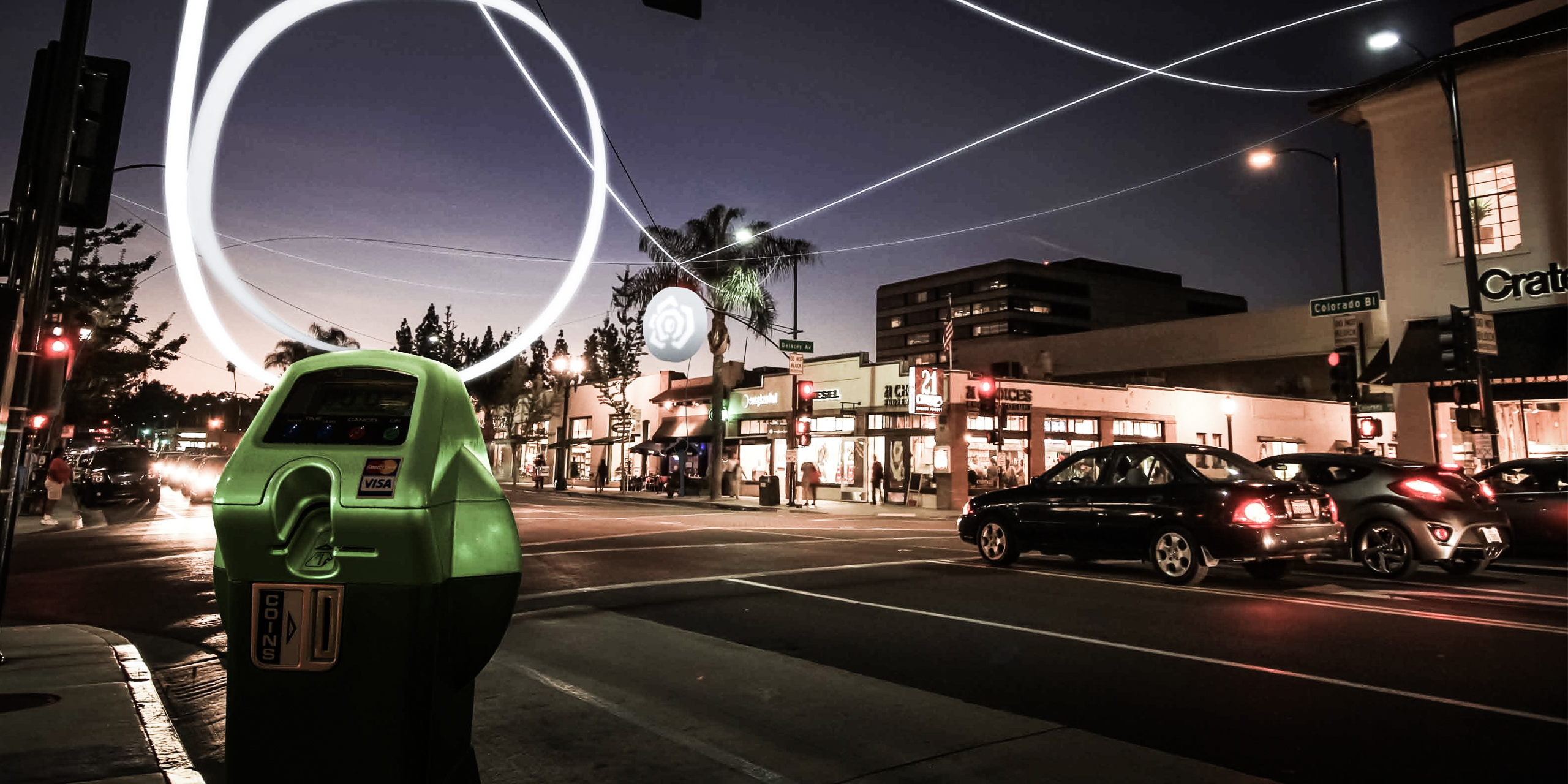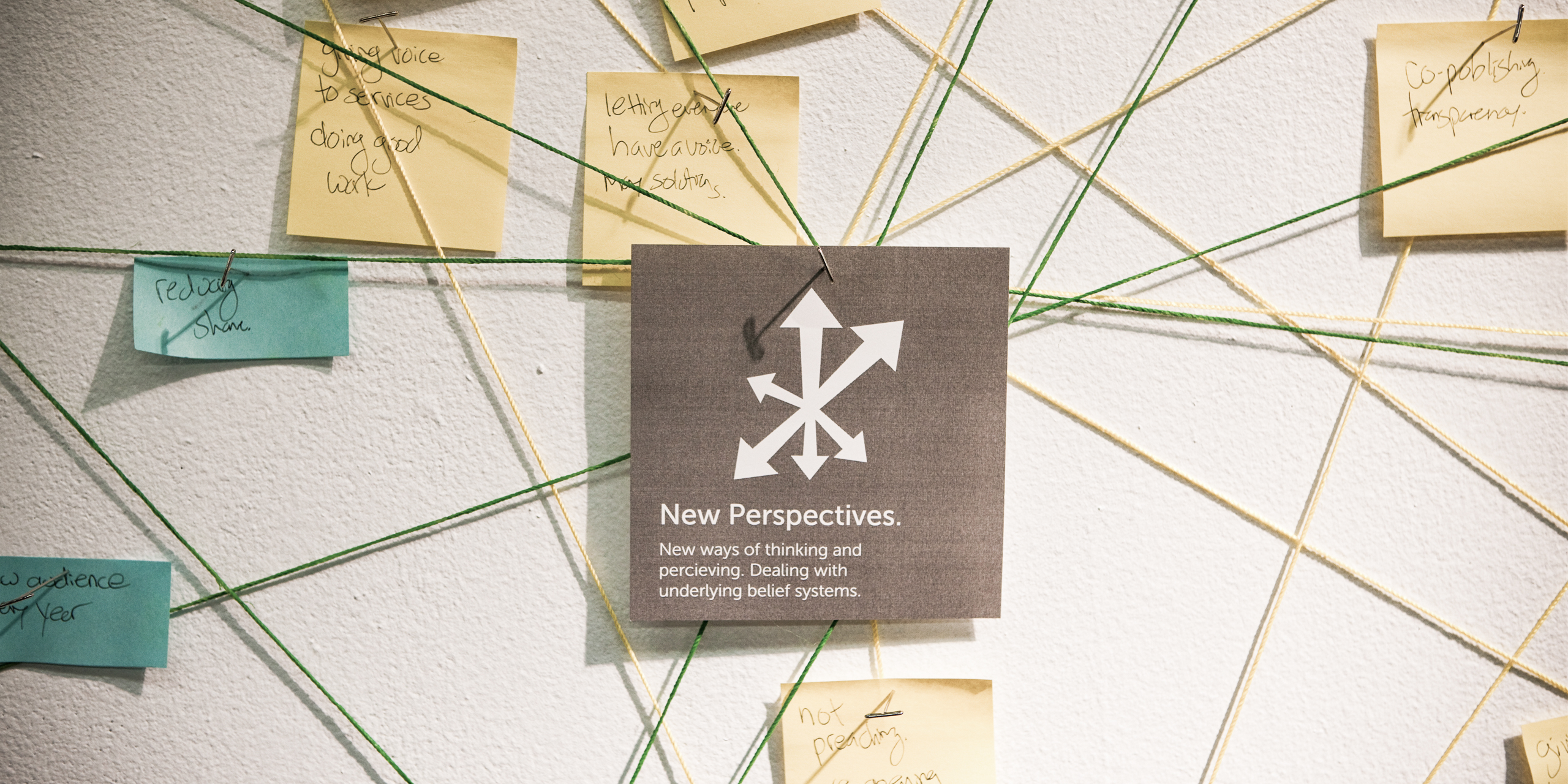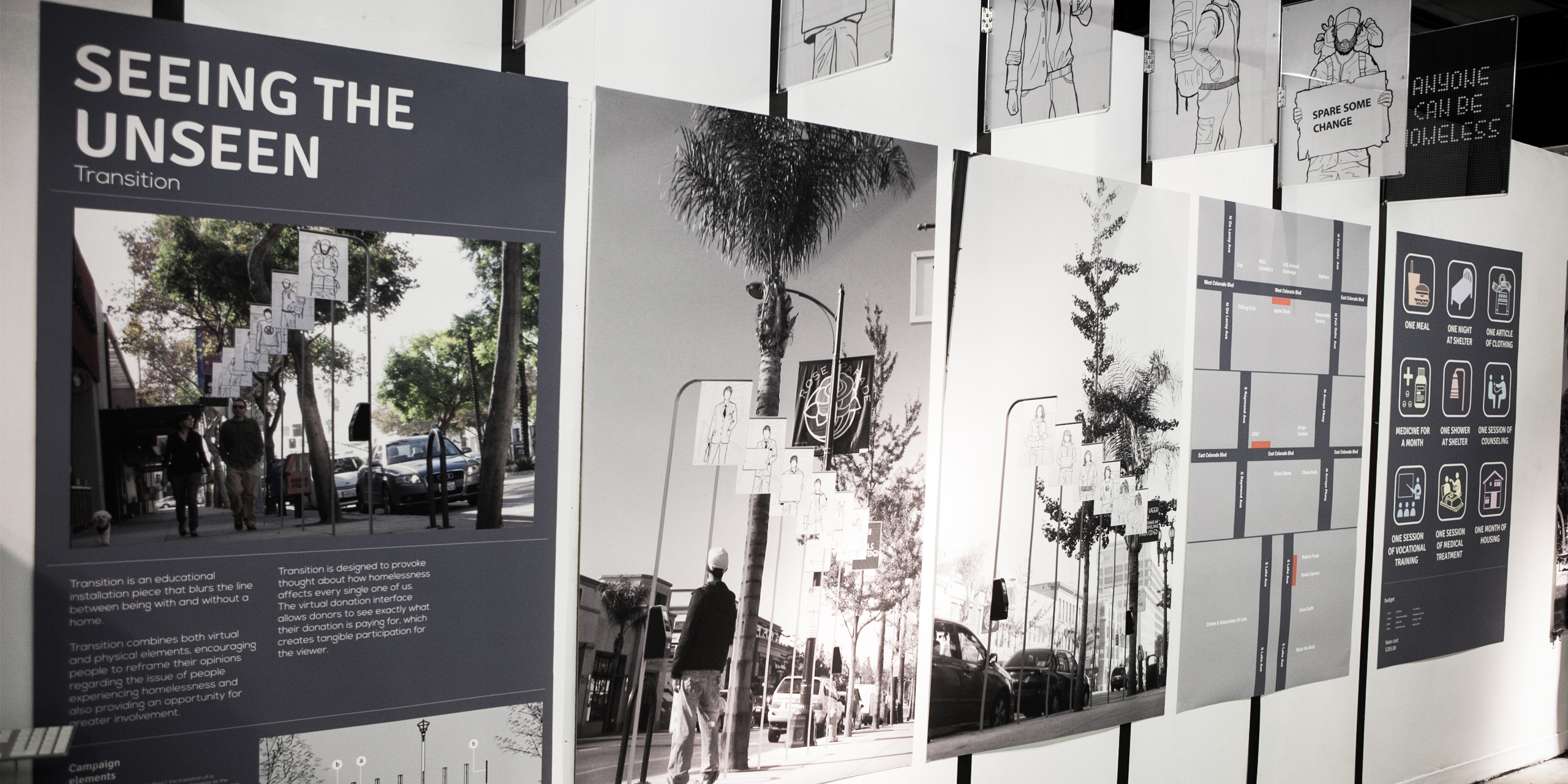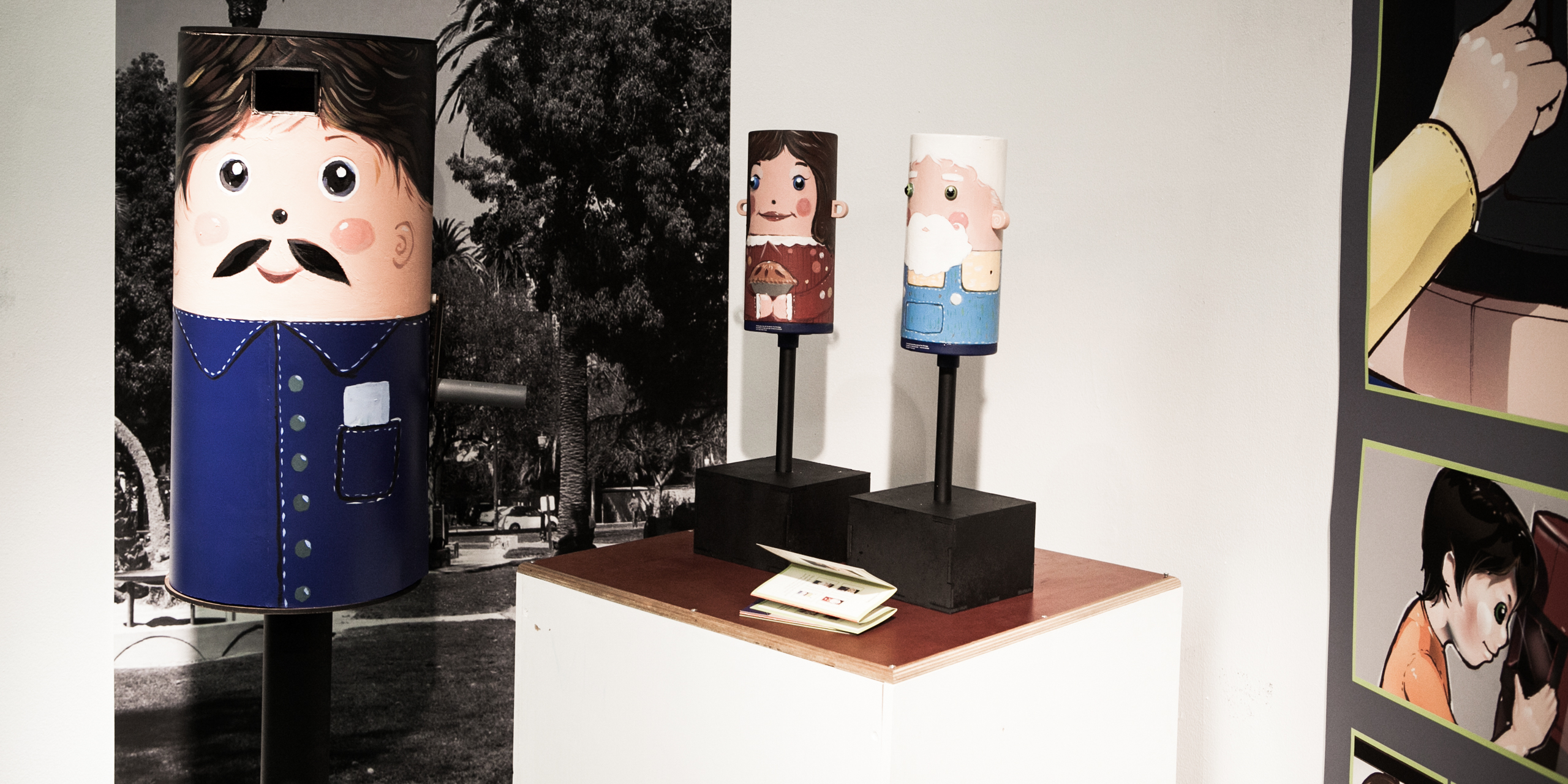Change on the Street
- Public Policy
- Social Entrepreneurship

Fall 2012
In the fall of 2012, ArtCenter students addressed two critical issues facing the city of Pasadena: homelessness and panhandling. Through the development of a public education campaign, and the design of re-purposed parking meters, the class sought ways to harness the community’s compassion into long-term solutions to end homelessness, and mitigate panhandling.
The engagement aspects of these projects are very appealing, and whenever we can employ ways to creatively engage people is good.
– Paul Little, President & CEO, Pasadena Chamber of Commerce
Background
The nation’s economic downturn adversely affected many residents of Pasadena. Recent data, from the Pasadena Homeless Count, estimates that residents experiencing homelessness have increased 12% since 2007. At that time, the count was 825, when taken again in 2012; the count had risen to 904. Though more of Pasadena’s residents need housing, employment and other supportive services, budgets have been cut back.
In addition to seeing growth in the problem of homelessness, Pasadena has also seen an increase in the presence of panhandlers across the city, of which there are two types: passive and aggressive. Passive panhandling is defined as a person soliciting a donation in a public space in a non-threatening manner, as when the person uses a cup and asks passersby for money. Often done on sidewalks, in parks and other public spaces, passive panhandling is legal when non-threatening and done on public property. Aggressive panhandling involves asking for money in ways that are threatening and aggressive, inappropriate and intimidating. It is illegal, considered a misdemeanor, and can result in tickets, fines or incarceration.
The City of Pasadena, the Business Area Improvement Districts and non-profit organizations have joined together with the goal of raising awareness of the homeless in Pasadena, and changing the behavior of how donors give to people experiencing homelessness. Achieving this goal means that money can be more targeted and effective, long-term solutions can be reached.
The outreach program encompasses: the installation of nine, re-purposed parking meters to collect donations from contributors, the creation of a public outreach and education campaign around the issues of homelessness, adverse effects of panhandling, and the redirecting of funds from panhandlers to homeless service providers and job training programs.
Believing that an educated community will result in better coordination of services and increased donations to service providers, the program will directly benefit those nonprofits, by donating 100% of parking meter donations to homeless service providers.
As educators, we present different points of view. That’s when the students become a little more honest, and when this becomes an emotional journey, one that reminds us that this could happen to all of us, and any of us.
– James Chu, Faculty, Product Design

Design Brief
Change on the Street was focused on designing a citywide campaign concept and outreach effort for Pasadena targeting chronic homelessness and panhandling. A multi-disciplinary team of students, led by faculty from the Product Design and Humanities & Sciences Departments, sought to connect the community’s compassion with the city’s ongoing work to find long-term solutions to homelessness and mitigate panhandling.
Students were challenged with creating a public education campaign that would provide multiple perspectives on people experiencing homelessness, inform residents about the existing resources available to homeless community members and the adverse effects of panhandling. A second project element tasked the students with designing re-purposed parking meters to be installed throughout the city to collect contributions. Art Center students, working closely with project partners, sponsors and other stakeholders, endeavored to create designs and prototypes that addressed the specific local needs of Pasadena in ways that matched the city’s culture and values.
Research and Product Development
Throughout the fourteen-week class, research was a key component. In depth and expansive, the research strongly impacted the students, helping inform their decisions by making visible the complexity of this issue and the different perspectives represented by the various stakeholders (replacing and determining plans of attack). Ongoing research allowed for constant inquiry in the real world, and served as a means to find breakthroughs. While gathering support for homeless services and reducing panhandling in Pasadena have areas of overlap, they are not intrinsically related, and so, to formulate potential solutions, data collection was necessary.
Research allowed the students to arm themselves with knowledge of what had come before and been done before, and then use that research to guide them forward.
– Arden Stern, Faculty, Humanities & Sciences

In weeks 1-5, the students employed three primary data gathering techniques: observation, interviewing and interpretation. Ethical guidelines, limits of research, and specific questions to ask were issues the students considered when determining their data collection plan. Subsequent to data collection, they developed tools for analyzing their data, aiding them in their ability to tell the stories of the people and the community. Documentation led to exploring a variety of interpretive methods, including: field notes, maps, drawings, timelines, interviews, ambient sound, artifact and archival materials gathering, and audio/visual representations of people, places, objects and events.
Week 6 brought the students to Pasadena’s Homeless Connect Day, allowing them to gain a deeper understanding of the city’s homeless situation and existing resources. This was followed by Week 7’s visit to Union Station Homeless Services and meetings with caseworkers. Here, the idea of “community” and “connection” to the city’s homeless situation was firmly established, which served to frame the project.
As the term progressed, the class self-divided into three teams. Each team identified and named archetypes, their “faces of the community,” allowing them to focus their campaign to specific people who were clearly etched upon their minds.
Through their research, Team Orange discovered other U.S. cities with unique parking meter programs, among them: Denver, Virginia Beach, and Nashville. Team Orange determined their project objective as bringing the community together to positively impact a person’s life, plus adapting existing infrastructure and donating habits. Their concepts sought to bring the community from a place of apathy, to a place of empathy. To do this, they focused on ideas compelling enough to make people stop, care and act. Multiple campaign concepts included: R.U.P.R: Respond, Uplift, Prevent and Reintegrate people; ART, building a tighter sense of community through art while educating the younger generations via fun meters; and CHANGE, which focused on people who visit Pasadena on a frequent basis.
I live in Pasadena and when we went out in the city with the class, I saw it in a different way, a way that felt like it was more reality based.
– So Hyun Park, Student, Product Design
A second team, Team US, developed a “Mindset Reset” that revolved around raising funds, raising awareness and raising hope. Through a strategy they called, “unexpected uncounters,” Team US developed a parking meter that talked, thereby grabbing the public’s attention in those critical first moments while they were walking past. In addition to conducting 25 surveys and 27 interviews in their research process, Team US created multiple archetype profiles around which they began building campaigns.
The third team, Northwall, developed a project called, “On Our Way Home.” They focused on making sustainable change, hope and home, and their goals also sought to foster compassion and find new ways of thinking about the problems of homelessness and panhandling, leading to an improved quality of life for all of Pasadena’s residents. Their archetypes led to project concepts: “Shine a Light on Me,” a “light of hope” created by metal tubing with LED lighting; the “Zombie Apocalypse Store,” to engage school age public in entertaining ways that over time would shift their thinking and contribution level; and “the Capsule,” providing low-cost manufactured housing to people caught between “the home is coming,” and “what do we do right now?”
Working in a semi-studio environment and in a group, let me see that not all of us have to agree on everything, but we all had to be heading in the same direction.
– Rayyan Toh, Student, Product Design
Outcomes
Outcomes updates
The students presented their solutions to the problem of homelessness and panhandling to: stakeholders, community members, and Art Center faculty and staff. With all three projects, tangibility was key, as was clear messaging that informed people as to how their donations were helping solve the problems of homelessness and panhandling.
 close
close
Transition: Seeing the Unseen.
Read moreDesign Team: Danny Lin, Chang-Hsuan Pai, Sue Park, Rayyan Toh
The team’s project name, “Seeing the Unseen,” was a direct outgrowth of their research, specifically, their interviews, which were conducted in Pasadena. Their concept was brought into focus in the wake of hearing community comments, like, “Homelessness is bad, but it doesn’t seem to be a problem here;” “I know they’re there, but I don’t think too much about them;” “It’s like they’ve become part of Pasadena architecture.” With a solidified project goal, defined as, “raising the money to help the homeless starts by raising awareness to the problem and issue,“ the team tasked themselves with creating “unexpected encounters” in Old Town Pasadena. The project concept was narrowed down to a single word: “Transition,” and through an educational installation that blurred the line between being with, and being without, a home, the team depicted the transition of becoming homeless and coming out of homelessness. Components of “Transition” were both physical and virtual. PHYSICAL: Hand drawn illustrations of faceless people, representing homeless members of the population, were depicted on street banners and displayed on a row of signposts. Walking in one direction, the public sees a faceless individual transitioning out of homelessness; approaching it from other direction, the public would see the opposite scenario: a person transitioning into homelessness. Engaging, yet non-intrusive, the banners serve to capture the public’s attention. Once interested, the public is able learn more by interacting with a virtual element. VIRTUAL: A street interface was the team’s take on the traditional parking meter. It would allow people to donate money to help end homelessness, and through specific choices on the “meter,” they could see what their money would buy and direct their donations accordingly. Among the choices: one meal, one shower at a shelter, one session of counseling, one night at a shelter, one month at a shelter. An LED signboard will display the donation choice, letting the donor feel that he or she is helping be a part of the solution to end homelessness in Pasadena.
 close
close
Change: Community Pasadena’s Popsees.
Read moreDesign Team: Vladimir Almonnord, Herbert Hsu, Jessica Lee, Mike Wang
Team Two addressed the aspect of community and its interaction with homelessness; their archetypes grew out of the people who live in, and who visit, the city of Pasadena. With their focus on reaching out and engaging the public, the team developed: “Popsees.” These large, durable and playful figures call attention to themselves and create instant engagement. Placed in a variety of locations around the city, through their brightly painted, friendly design, Popsees draw in the curious and invite them to take a closer look. Once drawn in, Popsees serve a more serious purpose: creating opportunities to teach children about homelessness. This is done through Popsees’ crank mechanism which, when activated, shows a short stop motion movie about the process of being housed, not being housed, then back to being housed. Three sets of designs allow Popsees to engage different target audiences. “Poppifams” are family friendly and are found in parks, schools and other safe places. “Iconic Popsees” are painted with the likenesses of: Jackie Robinson, Julia Childs, and other iconic Pasadena people. Spirit of Pasadena expresses the city’s culture through artists, the Tournament of Roses and others. Popsees are designed in two sizes: one has a viewfinder geared to an adult, a second is shorter, and with a viewfinder that fits a child’s sight line. A sliding door on the Popsee lets the individual donate, speakers allow for an audio component, and a sliding ear contains a personal message. Awareness and education come from the message and the film, and a Popsee touchpoint directs people to a central website for more information, as well as more personal stories, and more ways to donate. A future goal for Popsee is as a mascot for the city, and tied into city events. Yearly campaigns can be conducted to create a new Popsee, resulting in ongoing public engagement. Popsees can become a destination where families can go and interact, and where awareness of a serious city problem can be addressed in a way that parents and family members feel is appropriate to their child. Over time, recognizable Popsees will serve as starting points for discussions, as well as for donations directed at permanent solutions for the issue of homelessness.
 close
close
Shine A Light on Me.
Read moreDesign Team: Tyler Bennett, Andrew Lee, Kenneth Tay
Creating positive community action informed Team Three’s approach, out of which grew, “Shine a Light on Me.” Their view of donors was not simply as one-time givers, but rather as lifetime supporters, and their meter system provided the donor with a strong sense of community. By allowing people to donate at any level, Shine a Light on Me built ownership in the solution of chronic homelessness, and galvanized community action. Part art installation, part spectacle, the meter, entitled, ”The Light of Hope,” would shine a light on the issue in a way that focuses on the collective celebration of doing something positive. Light originates from the meter, circles around the donor’s face, and then goes up into a network of lights overhead and across the street. Ultimately, the light crosses the street and connects streetlight to streetlight at specific Pasadena locales. Different levels of giving result in different levels of light shows, but all donations are celebrated in light. Three types of meters are used in the campaign. A module only meter, which lights up when a donation is made; a system only meter, which lights up the network of lights; and the third, a full module plus system meter in which the donors’ face plus the network of lights are illuminated. The team envisioned rolling out posters, signage, and projections all designed to give the city a persona, which they saw as a city that believes in every single person living there. They created a web ad, stories of hope, and were interested in a “laddering technique” that would allow the campaign to be ongoing. The team believed that, in time, their campaign could serve as a way of attracting, not only the donating public, but also large organizations to come on board to sponsor meters. Team Three emphasized the collective nature of giving, where a dollar may not seem like much, but when four people give a dollar, or forty people give, the idea of community helping community becomes a reality. The complex issues of homelessness and panhandling can be addressed from multiple directions; this class provided one direction, showing how public art can contribute to the effectiveness of programs being considered for Pasadena’s targeted communities.
How the students saw these issues before they started the class and now, 14 weeks later–I don’t see how you can’t see them differently and feel differently, too. What they did was translate that to their projects, so that others could see these issues from different, even personal vantage points, and ultimately, they would care about them, too.
– Sherry Hoffman, Faculty, Humanities & Sciences
Next Steps
Working alongside the same partners from the City of Pasadena Housing Division, Flintridge Center and the Chamber of Commerce—this project’s second iteration will begin in Fall 2013, using the immersive community research from Change on the Street as a strong basis for understanding the complexities around homelessness. In a Fall 2013 studio led by the Graphic Design department, teams will develop a focused transmedia campaign with the aim of catalyzing funding support for permanent housing and other key homeless service providers in the City of Pasadena. Stay tuned for more info this fall.